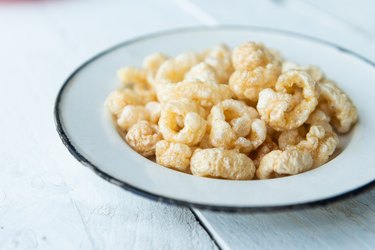
If pork rinds are a staple on your table every time you host a get together, you may want to find an alternative. Made by curing and frying the skin of pigs, it's no wonder that pork rinds nutrition includes significant calories and fat.
Like many other processed foods, pork rinds have high amounts of bad fats, cholesterol and sodium, which can be problematic for your health.
Video of the Day
Video of the Day
Pork Rinds Calories
Pork rinds are loaded with calories. A small 1-ounce serving, weighing a little over 28 grams, has 160 total calories, according to the USDA. Over half of the overall calories — 56 percent —come from fat.
On the other hand though, all of the remaining calories are from protein. You'll get 16 g protein in the same small serving. According to the National Academies of Sciences, adult males need 56 g per day and women need 46 g. Pork rinds provide close to 30 percent of that amount. Pork rinds are naturally free of carbohydrates.
Don't Overlook the Fat
Look at the whole picture when considering pork skin nutrition. For every ounce of pork rinds you snack on, you'll get nearly 9 grams of total fat. You can have some fat in your diet, although only 20 to 35 percent of your calories should come from it, according to the 2015-2020 Dietary Guidelines for Americans. In the case of a 2,000-calorie diet, you can have 44 to 78 grams of fat — 400 to 700 calories from fat, because fat has 9 calories per gram. If 2,000 calories is normal for you, just 1 ounce of pork rinds takes up 12 to 20 percent of your fat allotment for the entire day.
You'll get lots of unhealthy saturated fat and cholesterol from pork rinds. When these dangerous food components combine, they are more likely to raise your low-density lipoprotein, or LDL, than if either one is present alone.
Low-density lipoprotein raises your total cholesterol, clogs arteries and can increase your risk of heart attack, according to Mayo Clinic. To protect your heart, limit yourself to no more than 10 percent of total calories from saturated fat. That's a maximum of 200 calories from saturated fat, or 22 grams a day, states the 2015-2020 Dietary Guidelines for Americans.
One ounce of pork rinds contains over 3.2 grams of saturated fat —using up about 15 percent of the saturated fat you can have for the day for a 2,000-calorie diet.
Watch the Salt
Pork rinds are also high in sodium, yet another component that can be dangerous for your heart by increasing blood pressure. Food manufacturers often use salt while curing pork skin and then add even more for flavor during final processing. As long as your blood pressure is normal and you don't have any risk factors for heart disease, according to the American Heart Association reports that you can have up to 2,300 milligrams of sodium daily. But you'll have to reduce that down to 1,500 milligrams, if you're at risk of having heart problems.
An ounce of pork skins contains about 520 milligrams of sodium, taking up 22 to 35 percent of your allowance, depending on the category in which you fall.
- National Academies of Sciences: "Macronutrients"
- Mayo Clinic: "Dietary Fats: Know Which Type to Choose"
- American Heart Association: "Why Should I Limit Sodium?"
- Office of Disease Prevention and Health Promotion: "2015-2020 Dietary Guidelines for Americans"
- USDA National Nutrient Database: "Pork Rinds"
- FitDay: Nutrition Info For: Pork Skin, Rinds, Deep-Fried
- Harvard Medical School: Listing of Vitamins